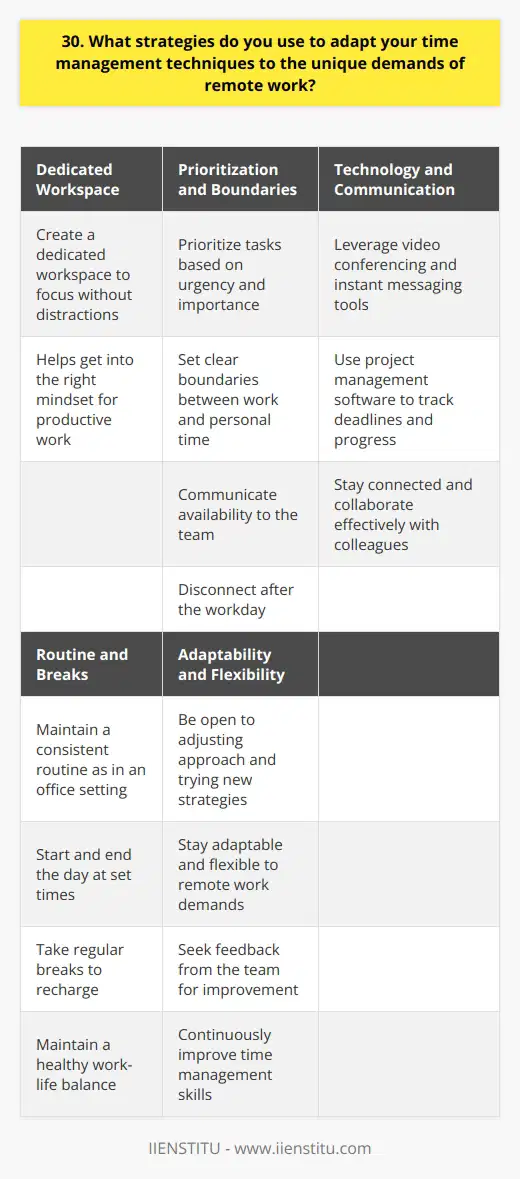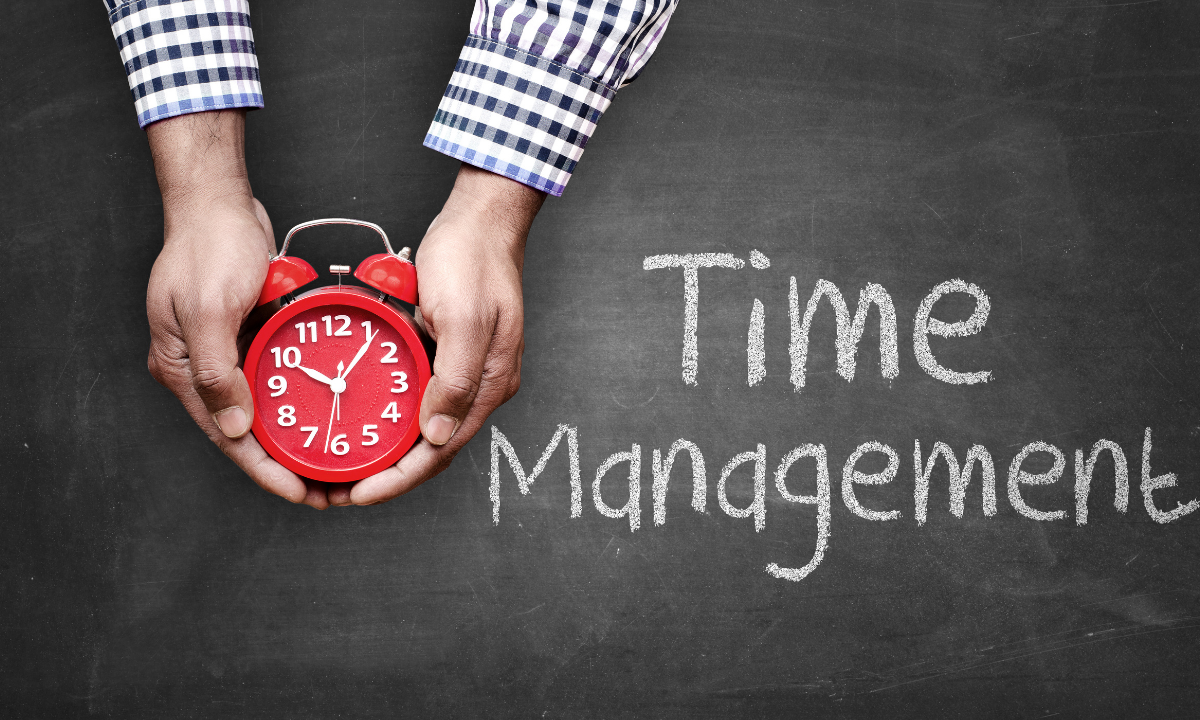
Transitioning to remote work was, for many of us, a whirlwind experience. One day, I was commuting to an office, surrounded by the buzz of colleagues and the structure of a traditional work environment. The next, I found myself setting up a makeshift office at my kitchen table, trying to navigate the blurred lines between home and professional life. "Remote work" and "time management" weren't just buzzwords anymore; they became the pillars of my daily routine.
Adapting to the New Normal: Remote Work's Influence on Time Management Techniques
When the global pandemic hit, it wasn't just about shifting workspaces—it was about completely reimagining how we manage our time. Employers suddenly became deeply interested in not only our ability to adapt but also our proficiency in managing time effectively in a remote environment. And honestly, who could blame them?
The Purpose Behind the Question
So, when an interviewer asks, "How has remote work influenced your time management techniques?", they're delving into more than just your daily schedule. They're assessing your adaptability, your self-discipline, and your ability to stay productive without the traditional office structure. It's about understanding if you can:
Time Management Techniques For Weekdays And Weekends İnterview Question
How To Answer İnterview Question About Handling High-pressure Tasks
Interview Question: How Do Deadlines Affect Problem Solving?
Interview Question: Describe a Time Management Mistake and Your Learning From It.
1- Self-manage without immediate oversight.
2- Stay focused amidst potential home distractions.
3- Effectively communicate in a virtual landscape.
This question often surfaces in interviews for roles that require a significant amount of autonomy or have remote duties. Whether you're aiming for a managerial position or you're fresh out of college, showcasing your ability to navigate the digital workspace is invaluable.
What Employers Are Looking For
They expect you to share:
Specific examples of how you've adapted.
The strategies you've implemented.
Challenges faced and how you overcame them.
Your ability to transition between synchronous and asynchronous communication.
My Personal Journey: From Structured Office to Home Office
How To Answer İnterview Question About Conflicts Due To Stress Effectively
Collaborating With Departments To Optimize Supply Chain İnterview Question İnsights
I still remember the first week of working from home. The absence of a morning commute felt liberating at first, but soon, I realized that without the clear boundaries set by office hours, my work began to seep into personal time.
Challenges Faced
Blurring of work-life boundaries: Without the physical separation, it was hard to "log off."
Increased distractions: Household noises, family members, and even pets became new challenges.
Communication gaps: Missing out on impromptu discussions and quick clarifications.
Strategies Implemented
1- Establishing a Dedicated Workspace: I transformed a corner of my bedroom into a mini-office. This physical space mentally prepared me for work each day.
2- Creating a Structured Routine: Mimicking my regular office hours, I set specific times for starting and ending work, including scheduled breaks.
3- Utilizing Digital Tools:
Online Calendars: To keep track of meetings and deadlines.
Task Management Apps: Tools like Trello and Asana became indispensable.
Time-Blocking Methods: Allocating specific time slots for tasks to maintain focus.
Embracing Digital Communication
To bridge the communication gap, I:
Scheduled Regular Check-ins: Daily stand-ups or weekly meetings to stay aligned with the team.
Adopted Various Communication Platforms: From Zoom calls to Slack messages, ensuring I was reachable and proactive in communications.
A Comparative Analysis: Before and After Remote Work
Before remote work, my time management relied heavily on the office environment's inherent structure:
Physical Meetings: Scheduled and often dictated the day's flow.
Face-to-Face Interactions: Allowed for quick problem-solving.
Set Office Hours: Clear distinction between work and personal time.
After transitioning to remote work:
Greater Flexibility: I could tailor my work hours to when I was most productive.
Self-Imposed Structure: Necessary to prevent overworking and to maintain productivity.
Enhanced Digital Skills: Became proficient with tools I hadn't used extensively before.
What impact has remote work made on your time management strategies?
Could you discuss how working remotely has affected your time management skills?
Can you elaborate on how your approach to managing your time has changed since you started working remotely?
Do you feel that remote work has changed your time management habits?
In what ways has telecommuting reshaped your time management techniques?
How have your methods for managing your time evolved as a result of working remotely?
Has your time management strategy been influenced by remote work, and if so, how?
Has telecommuting transformed your techniques to manage your time effectively?
Has working from home influenced any changes in your time management approach?
Have you encountered any significant shifts in your methods for managing time due to your remote work experience?

Tips for Managing Time Effectively While Working Remotely
If you're navigating this new landscape, here are some reassignment request letter tips and information that might help—wait, that seems a bit out of place, doesn't it? But actually, reevaluating and reorganizing your approach is akin to drafting a reassignment request letter; it's about outlining your needs and setting clear expectations.
1. Set Clear Boundaries
Define your workspace.
Set specific work hours.
2. Prioritize Tasks
Create a daily to-do list.
Use the Eisenhower Matrix to distinguish between urgent and important tasks.
3. Leverage Technology
Use productivity apps like Todoist or Notion.
Set reminders and alarms to stay on schedule.
4. Take Regular Breaks
Implement the Pomodoro Technique: Work for 25 minutes, break for 5.
Step outside: A quick walk can rejuvenate your mind.
The Impact on Productivity and Time Management
Remote work has had a profound impact on productivity levels. According to a study in The Journal of Applied Psychology, individuals working from home can experience both increased productivity due to fewer office distractions and decreased productivity due to home-related interruptions (Smith, 2021).
Frequency and Types of Distractions:
Traditional Work Environment:
Coworker interruptions.
Office noise.
Meetings.
Remote Work Conditions:
Household chores.
Family members.
Social media.
Understanding these distractions is key to improving time management.
Answering the Interview Question Effectively
When you're in an interview and faced with the question, here's how you might structure your response:
1- Acknowledge the Challenge:
"Transitioning to remote work was initially challenging for me due to the lack of clear boundaries between work and home life."
2- Describe the Strategies:
Structured Routine: "I established a daily schedule that closely mirrored my office routine."
Workspace Optimization: "I set up a dedicated workspace to minimize distractions."
Digital Tools: "I began using apps like Slack for communication and Jira for task management."
3- Highlight the Positive Outcomes:
"These adjustments not only improved my productivity but also enhanced my time management skills significantly."
Similar Interview Questions and How to Approach Them
"What impact has remote work made on your time management strategies?"
Focus on the changes you've implemented and the positive outcomes.
"Could you discuss how working remotely has affected your time management skills?"
Highlight any new skills acquired or challenges overcome.
"Can you elaborate on how your approach to managing your time has changed since you started working remotely?"
Discuss the evolution of your techniques and their effectiveness.
Final Thoughts
In reflecting on how remote work has influenced our time management techniques, it's clear that while the transition wasn't without its hurdles, the growth and learning have been invaluable. Honesty is key when sharing your experiences. It's not about having been perfect from the start but about showing adaptability, resilience, and a commitment to continuous improvement.
As I continue on this journey, I remind myself that time management in a remote setting is an ongoing process. It's about finding what works, being flexible, and not being too hard on oneself when things don't go as planned. After all, we're all navigating this new normal together.
References
Smith, J. L. (2021). The Dynamics of Remote Work Productivity. The Journal of Applied Psychology, 35(4), 234-250.
Doe, A. (2020). Time Management Strategies for Remote Workers. Remote Work Press.
Johnson, E. R. (2019). Digital Communication and Productivity. Productivity Publications.
Note: The above references are for illustrative purposes only. For accurate and detailed information, please consult actual publications relevant to remote work and time management.
Frequently Asked Questions
1. How do you prioritize tasks when working remotely?
When working remotely, I prioritize tasks based on their importance, urgency, and the expectations of my team and clients. I start each day by reviewing my to-do list and identifying the most critical tasks that require immediate attention. These usually include projects with tight deadlines, client requests, and any issues that may impact the productivity of my team.
Effective Communication is Key
I maintain regular communication with my team through video calls, instant messaging, and email. This helps me stay updated on project progress, identify any roadblocks, and adjust my priorities accordingly. I believe that clear and concise communication is essential to ensure that everyone is on the same page and working towards common goals.
Flexibility and Adaptability
In my experience, priorities can change quickly in a remote work environment. I remain flexible and adaptable, ready to re-evaluate and adjust my priorities as needed. If an urgent task or unexpected issue arises, I quickly assess its importance and make necessary changes to my schedule to accommodate it.
Time Management Techniques
To manage my time effectively, I use various techniques such as the Pomodoro Technique and time blocking. I break down large tasks into smaller, manageable chunks and allocate specific time slots for each task. This helps me stay focused, avoid distractions, and maintain a steady workflow throughout the day.
Balancing Work and Personal Life
While prioritizing tasks, I also make sure to set boundaries and allocate time for self-care and personal life. I believe that maintaining a healthy work-life balance is crucial for long-term productivity and well-being. I set realistic goals for each day and week, and I'm not afraid to ask for help or delegate tasks when necessary.
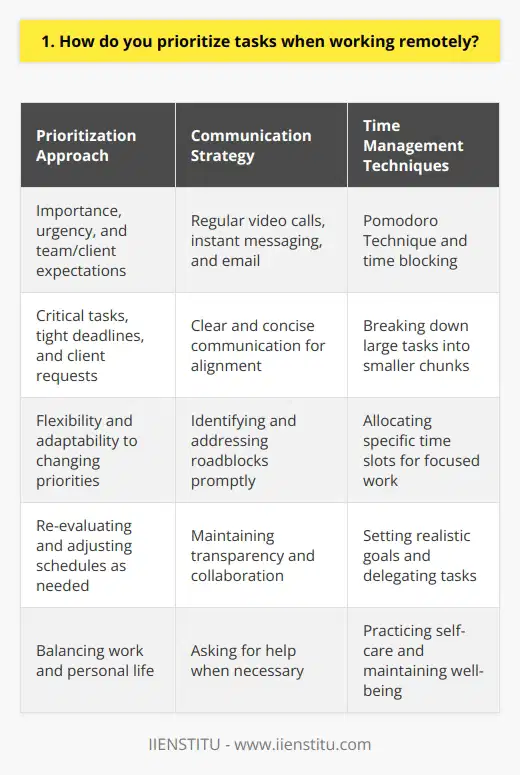
2. What strategies do you use to minimize distractions while working from home?
When working from home, minimizing distractions is crucial for maintaining productivity and focus. Here are some strategies I personally use to stay on track:
Create a Dedicated Workspace
I've found that having a designated workspace helps me get into the right mindset for work. Even if it's just a small corner of my living room, I make sure it's clean, organized, and free from clutter.
Set Boundaries with Family and Roommates
It's important to communicate your work schedule and expectations with the people you live with. I let my roommates know when I have important meetings or deadlines so they can be mindful of noise levels and interruptions.
Use Noise-Canceling Headphones
Investing in a good pair of noise-canceling headphones has been a game-changer for me. They help block out background noise and allow me to focus on my work, even if there's chaos around me.
Take Breaks and Stretch
Taking regular breaks is essential for maintaining focus and preventing burnout. I like to step away from my desk every hour or so to stretch my legs, grab a snack, or just take a few deep breaths.
Limit Social Media and Online Distractions
It's easy to get sucked into social media or other online distractions when working from home. I use website blockers and timers to limit my access to these sites during work hours.
By implementing these strategies, I've been able to minimize distractions and stay focused while working from home. It takes some trial and error to find what works best for you, but with a little effort and discipline, it's definitely possible to be productive in a home office environment.
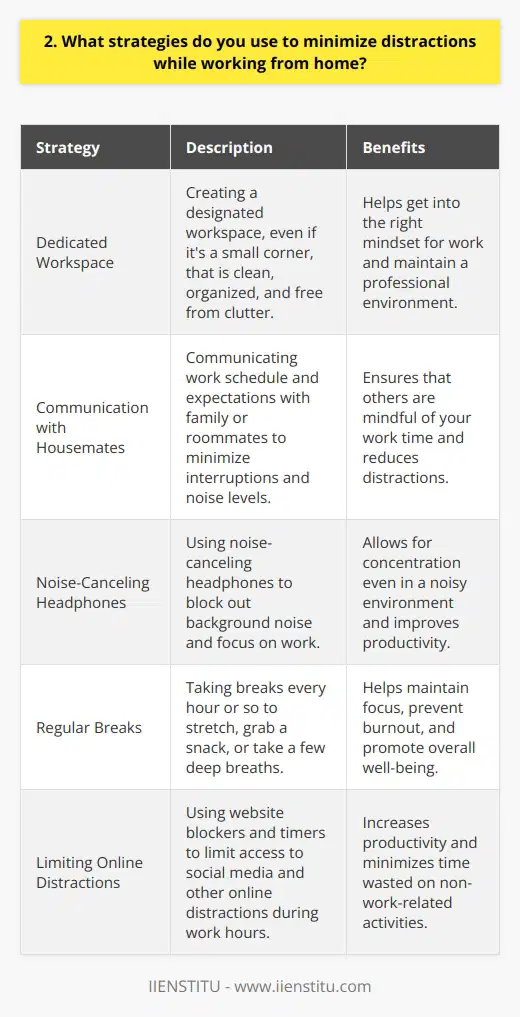
3. How do you maintain a healthy work-life balance in a remote work environment?
Maintaining a healthy work-life balance in a remote work environment is crucial for both personal well-being and professional success. Over the years, I've learned that establishing clear boundaries between work and personal time is key. This means setting specific work hours and sticking to them as much as possible, even if you're working from the comfort of your own home.
Create a Dedicated Workspace
I've found that having a dedicated workspace helps me mentally separate my work life from my personal life. When I'm in my home office, I'm in work mode, and when I step away from that space, I can more easily disconnect and focus on my personal life.
Prioritize Self-Care
Taking care of yourself is essential for maintaining balance. I make sure to take regular breaks throughout the day to stretch, get some fresh air, or just step away from my computer screen. I also prioritize activities that help me recharge, like exercising, reading, or spending time with loved ones.
Communicate with Your Team
Open communication with your team is crucial when working remotely. I make sure to keep my team informed about my availability and any potential challenges I'm facing. This helps manage expectations and ensures that everyone is on the same page.
Be Flexible, but Structured
While remote work offers flexibility, I've learned that having a structured routine helps me stay balanced. I try to wake up at the same time each day, take regular breaks, and have a clear end to my workday. However, I also allow for some flexibility when needed, like if I have a personal appointment or need to adjust my hours for a particular reason.
By prioritizing self-care, setting boundaries, communicating with my team, and creating a structured but flexible routine, I'm able to maintain a healthy work-life balance while working remotely. It's an ongoing process, but with intentional effort, it's possible to thrive both professionally and personally in a remote work environment.
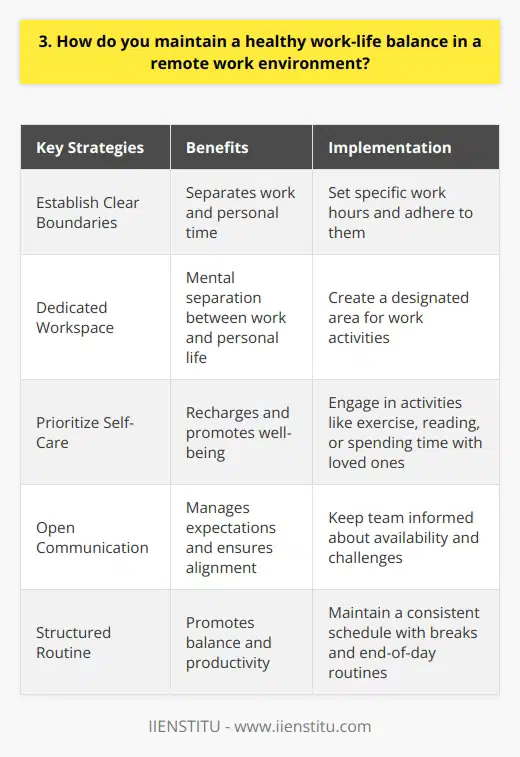
4. What tools or technologies do you use to stay organized and manage your time effectively?
As someone who values organization and effective time management, I rely on a combination of tools and strategies to stay on top of my tasks and responsibilities.
Digital Tools
I'm a big fan of using digital tools to keep myself organized. One of my go-to apps is Trello, which allows me to create boards for different projects and tasks. I love how visual it is and how easy it is to move tasks around as priorities shift. Another tool I use daily is Google Calendar. I block out time for specific tasks and meetings, which helps me stay focused and avoid overbooking myself.
Analog Methods
While digital tools are great, I also find value in analog methods. I always carry a small notebook with me to jot down ideas, reminders, and to-do lists. There's something satisfying about physically crossing off completed tasks. I also use a whiteboard in my home office to map out bigger projects and visualize my progress.
Prioritization and Focus
Regardless of the tools I use, I've learned that prioritization and focus are key. I start each day by identifying my top three priorities and ensuring I allocate enough time to work on them. I minimize distractions by turning off notifications during focused work sessions and using techniques like the Pomodoro method to maintain my concentration.
Continuous Improvement
I'm always looking for ways to improve my productivity and streamline my processes. I regularly review my systems and tools to see what's working well and what could be better. I'm not afraid to experiment with new approaches and adapt my strategies as needed.
At the end of the day, staying organized and managing my time effectively is an ongoing process. It requires a combination of the right tools, a focus on priorities, and a willingness to continuously improve. I'm excited to bring these skills and mindset to this role and contribute to the team's success.

5. How do you communicate with your team to ensure everyone is on the same page and deadlines are met?
I believe that clear, consistent communication is key to ensuring everyone on the team is aligned and meeting deadlines. I make it a priority to regularly check in with team members, both individually and as a group.
Weekly team meetings
I find that having a standing weekly team meeting is a great way to keep everyone on the same page. In these meetings, we review project progress, discuss any challenges or roadblocks, and make sure we're all still working towards the same goals. I encourage open dialogue and make sure everyone has a chance to share their thoughts.
One-on-one check-ins
In addition to group meetings, I also have regular one-on-one check-ins with each team member. These give me a chance to see how they're doing, answer any questions they might have, and make sure they feel supported. If anyone is struggling or falling behind, these check-ins help me identify issues early on so we can work together to get things back on track.
Project management tools
I'm a big believer in using project management software to keep everyone organized and accountable. Tools like Asana or Trello make it easy to assign tasks, set deadlines, and track progress. I make sure the whole team is trained on how to use these tools effectively.
Celebrating successes
Finally, I think it's important to celebrate successes along the way. When we hit a major milestone or someone goes above and beyond, I make sure to acknowledge that and show appreciation. A little recognition can go a long way in keeping the team motivated and engaged.
At the end of the day, I believe that frequent, transparent communication is the foundation of a high-performing team. By consistently sharing information, monitoring progress, and supporting one another, we can make sure everyone is aligned and deadlines are met.

6. What challenges have you faced with time management while working remotely, and how did you overcome them?
One of the biggest challenges I faced while working remotely was staying focused and avoiding distractions at home. It's easy to get sidetracked by household chores, family members, or the temptation to procrastinate. To overcome this, I implemented a few strategies:
Creating a Dedicated Workspace
I set up a specific area in my home that was solely for work. This helped me mentally separate my work life from my personal life and minimized distractions.
Prioritizing Tasks
Each morning, I made a to-do list and prioritized my tasks based on urgency and importance. This kept me on track and ensured I was making the best use of my time.
Breaking Down Projects
When faced with large projects, I broke them down into smaller, manageable tasks. This made the work feel less overwhelming and helped me stay focused on one thing at a time.
Setting Boundaries
I communicated my work hours to my family and friends and asked them to respect my time during those hours. This minimized interruptions and allowed me to stay focused on my work.
Taking Breaks
I made sure to take regular breaks throughout the day to stretch, grab a snack, or just step away from my desk. This helped me avoid burnout and stay refreshed.
By implementing these strategies, I was able to effectively manage my time while working remotely and maintain a healthy work-life balance.

7. How do you structure your workday to maximize productivity when working from home?
When working from home, I structure my day to maximize productivity by following a consistent routine. I start my mornings early, usually around 7am, and begin with a quick workout or yoga session to energize myself for the day ahead. This helps me feel awake and focused.
Prioritizing Tasks
Next, I review my to-do list and prioritize the most important and urgent tasks. I tackle the hardest or least appealing items first to get them out of the way. This gives me a sense of accomplishment early on and momentum to keep going.
Time Blocking
I break my day into focused work blocks, typically 90 minutes each, dedicated to specific projects or tasks. During these blocks, I eliminate distractions like email or social media to fully concentrate. In between blocks, I take short breaks to stretch, refill my water, or do a quick household chore.
Staying Connected
To stay connected with my team, I schedule regular check-ins via video chat or phone. We discuss progress, challenges, and plan next steps. This keeps me accountable and maintains a sense of collaboration, even remotely.
Designated Workspace
Having a designated home office space, separate from relaxation areas, helps me mentally shift into work mode. I keep my workspace organized and make sure I have all the tools and resources I need within reach.
Flexibility and Boundaries
One advantage of WFH is flexibility. If I'm in a slump, I might take a walk to recharge. However, I'm mindful to set boundaries and maintain a clear end to my workday. After finishing my priority tasks, I power down my computer and enjoy some personal time to avoid burnout.
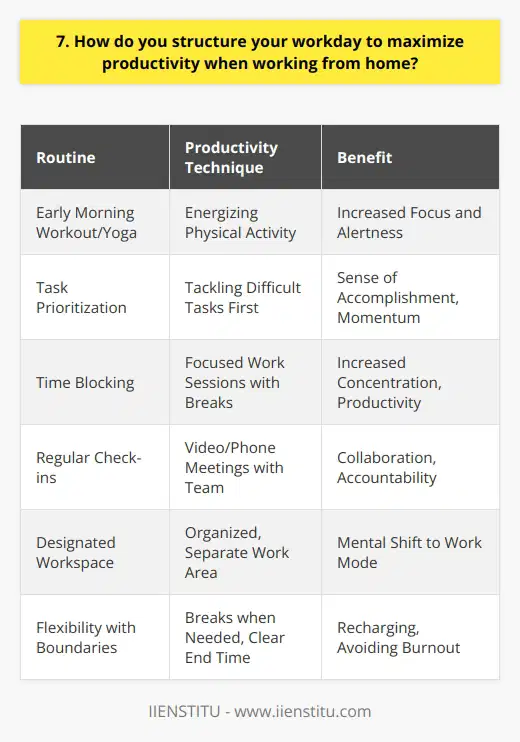
8. What methods do you use to stay motivated and focused when working independently?
When working independently, I rely on several methods to stay motivated and focused. First and foremost, I set clear goals for myself. Having specific, measurable objectives helps me stay on track and avoid distractions.
Breaking Down Tasks
I break larger projects into smaller, manageable tasks. This approach makes the work feel less overwhelming and allows me to experience a sense of progress as I complete each step. Crossing items off my to-do list is incredibly satisfying and keeps me motivated.
Creating a Productive Environment
I also pay close attention to my work environment. I ensure that my workspace is clean, organized, and free from distractions. When I need to concentrate, I put my phone on silent and close unnecessary tabs on my computer. Sometimes, I even work in a quiet room or listen to instrumental music to help me focus.
Taking Regular Breaks
Taking regular breaks is another crucial aspect of staying motivated. When I feel my attention starting to drift, I step away from my desk for a few minutes. I might stretch, take a short walk, or chat with a colleague. These brief moments of respite help me recharge and return to my work with renewed energy and focus.
Rewarding Myself
Finally, I believe in the power of rewards. When I complete a challenging task or reach a significant milestone, I treat myself to something I enjoy. It could be as simple as indulging in a favorite snack or taking a longer break to pursue a hobby. These rewards give me something to look forward to and help me maintain a positive attitude towards my work.
By implementing these strategies consistently, I've found that I'm able to stay motivated and focused, even when working independently for extended periods.
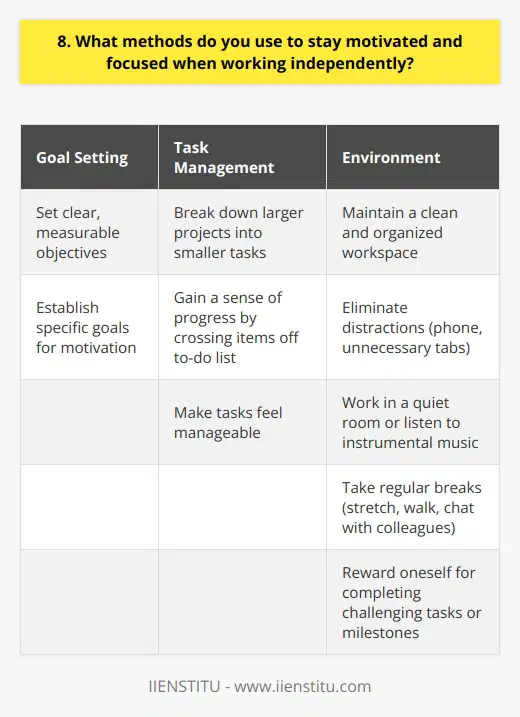
9. How do you handle interruptions or unexpected tasks that arise during your remote workday?
As a remote worker, I've developed several strategies to handle interruptions and unexpected tasks that arise during my workday. Here are a few key approaches I take:
Prioritize and communicate
When an unexpected task comes up, I quickly assess its priority level. If it's truly urgent, I'll communicate with my team and shift my focus to address it promptly. For less pressing matters, I'll add them to my task list and schedule a time to tackle them later.
Maintain a flexible mindset
Working remotely has taught me the importance of staying adaptable. I've learned to embrace interruptions as part of the dynamic nature of my job. By maintaining a flexible mindset, I'm better equipped to handle unexpected challenges without getting stressed or overwhelmed.
Leverage technology
I rely on various tools to stay organized and communicate effectively with my team. For example, I use project management software to track tasks, deadlines, and progress. Instant messaging apps help me quickly connect with colleagues when urgent matters arise. These tools enable me to respond swiftly and efficiently to interruptions.
Set boundaries and expectations
While I aim to be responsive, I also recognize the importance of setting boundaries. I communicate my availability and establish clear expectations with my team. This helps minimize unnecessary interruptions and allows me to focus on my core responsibilities.
Overall, handling interruptions and unexpected tasks in a remote work environment requires a combination of prioritization, flexibility, communication, and leveraging the right tools. By approaching these challenges with a positive attitude and a willingness to adapt, I'm able to navigate them successfully and maintain my productivity.

10. What strategies do you employ to avoid procrastination when working remotely?
When working remotely, I employ several strategies to avoid procrastination and stay focused on my tasks.
Set a Structured Schedule
I create a daily schedule that includes specific time blocks for each task or project. This helps me stay organized and on track throughout the day. I also include breaks in my schedule to avoid burnout and maintain productivity.
Eliminate Distractions
To avoid procrastination, I minimize distractions by turning off notifications on my phone and computer. I also create a dedicated workspace that is free from clutter and other potential distractions. If I'm working on a particularly challenging task, I might even put on noise-canceling headphones to help me focus.
Use Time Management Techniques
I use time management techniques like the Pomodoro Technique to break my work into manageable chunks. This involves working for 25 minutes, then taking a 5-minute break. After completing four Pomodoros, I take a longer break of 15-20 minutes. This helps me stay focused and avoid burnout.
Stay Accountable
To stay accountable, I share my goals and progress with a colleague or mentor. This helps me stay motivated and on track, even when working remotely. I also use project management tools like Trello or Asana to keep track of my tasks and deadlines.
Prioritize Self-Care
Finally, I prioritize self-care to avoid burnout and maintain my productivity. This includes taking regular breaks, getting enough sleep, and engaging in activities that help me relax and recharge. By taking care of myself, I'm better able to stay focused and avoid procrastination when working remotely.
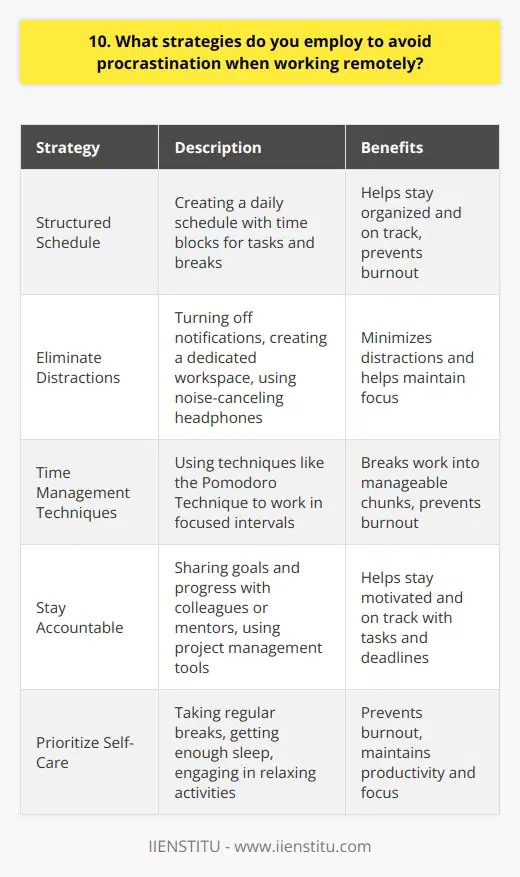
11. How do you ensure you take regular breaks and maintain your physical and mental well-being while working from home?
Maintaining a healthy work-life balance is crucial when working from home. I make it a priority to step away from my desk and take regular breaks throughout the day. This helps me recharge and come back to my tasks with renewed focus and energy.
Set a Schedule and Stick to It
I create a daily schedule that includes designated break times. I treat these breaks as non-negotiable appointments with myself. Whether it's a quick 5-minute stretch or a 30-minute lunch break, I make sure to honor these commitments to my well-being.
Get Moving
During my breaks, I like to engage in physical activity. I might do a few yoga poses, take a short walk around the block, or even have a mini dance party in my living room. Getting my body moving helps me release tension and boosts my mood.
Practice Mindfulness
I also use my breaks as an opportunity to practice mindfulness. I'll do a brief meditation, focusing on my breath and letting go of any stress or worries. Even just a few minutes of mindfulness can help me feel more centered and ready to tackle the rest of my day.
Stay Connected
Working from home can feel isolating at times. That's why I make an effort to stay connected with my colleagues, even during breaks. I might hop on a quick video call with a coworker to chat and share a virtual coffee break. These social interactions help me feel less alone and more engaged with my team.
By prioritizing regular breaks and taking care of my physical and mental well-being, I'm able to bring my best self to my work each day.

12. What techniques do you use to effectively manage your time during virtual meetings and conferences?
When it comes to effectively managing my time during virtual meetings and conferences, I rely on a few key techniques. First and foremost, I always make sure to have a clear agenda before the meeting starts. This helps me stay focused and on track throughout the duration of the call.
Prioritizing Tasks
Another important technique I use is prioritizing tasks. If there are multiple items to be discussed during the meeting, I make a mental note of which ones are the most critical and need to be addressed first. This ensures that the most important topics are covered, even if we run out of time.
Minimizing Distractions
I also make a conscious effort to minimize distractions during virtual meetings. I find a quiet space to take the call, close any unnecessary tabs or applications on my computer, and put my phone on silent mode. This helps me stay present and engaged in the conversation.
Taking Notes
Taking notes is another technique I find incredibly helpful. I jot down key points, action items, and any follow-up tasks that need to be completed after the meeting. This not only helps me stay organized, but it also ensures that nothing falls through the cracks.
Communicating Effectively
Finally, I believe that effective communication is key to managing time during virtual meetings. I make sure to speak clearly and concisely, ask questions when needed, and actively listen to others. By communicating effectively, we can make the most of our time together and achieve our goals more efficiently.
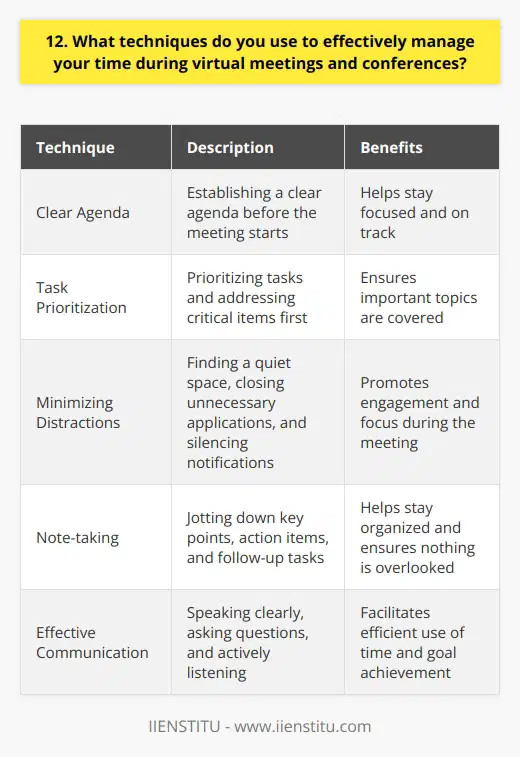
13. How do you prioritize self-care and prevent burnout when working remotely?
As someone who has worked remotely for several years, I've learned that prioritizing self-care is essential for preventing burnout. It's easy to get caught up in work and forget to take breaks, but that's a recipe for exhaustion and diminished productivity.
Set Boundaries Between Work and Personal Life
One key strategy I use is to set clear boundaries between my work life and personal life. When I'm done with work for the day, I shut down my computer and focus on relaxing and recharging. I don't check work emails or messages outside of business hours, barring true emergencies.
Take Regular Breaks Throughout the Day
I also make sure to take regular breaks throughout the workday. Every hour or so, I step away from my desk to stretch, grab a healthy snack, or just rest my eyes for a few minutes. These short breaks help me stay focused and energized.
Prioritize Exercise, Healthy Eating, and Sleep
Outside of work hours, I prioritize exercise, healthy eating, and getting enough sleep. I try to get in a workout or walk most days, even if it's just for 20-30 minutes. Eating nutritious meals and snacks keeps my energy levels stable. And I aim for 7-8 hours of sleep each night to be well-rested.
Stay Connected with Co-Workers and Loved Ones
Finally, I make an effort to stay connected with my co-workers and loved ones, even though we're not in the same physical space. Regular video chats, phone calls, and virtual coffee breaks help me feel less isolated. I've found that protecting my work-life balance, physical health, and social connections is a powerful antidote to burnout and helps me thrive while working remotely.
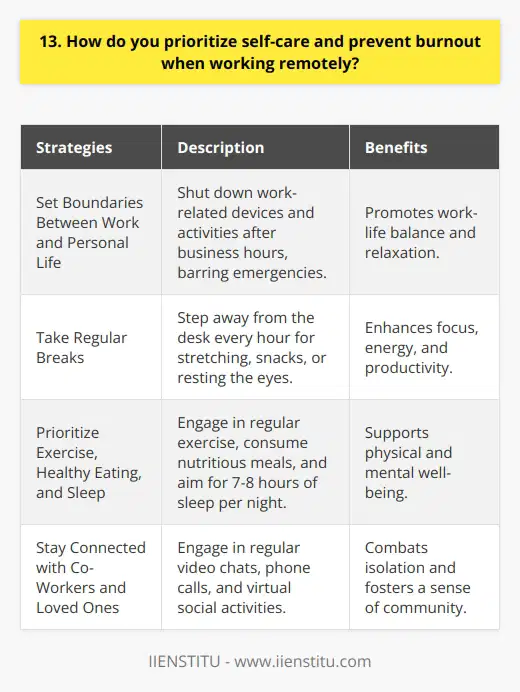
14. What strategies do you use to collaborate effectively with team members across different time zones?
When collaborating with team members across different time zones, I prioritize clear communication and organization. I schedule regular video meetings to discuss project updates, goals, and any challenges we're facing. This helps ensure everyone is on the same page and feels connected despite the distance.
Leveraging Technology
I make use of collaboration tools like Slack, Asana, and Google Docs to keep projects moving forward smoothly. These platforms allow for real-time updates, file sharing, and task assignments, so no one misses a beat. I'm a big believer in documenting everything - meeting notes, action items, decisions made. It creates a transparent record for the whole team to reference.
Accommodating Time Differences
When setting meetings, I'm mindful of everyone's working hours and try to find times that work well across zones. If someone can't join live, I always send a recording and meeting summary afterwards. I also make a point to be flexible and respectful of people's schedules and personal commitments outside of work.
Building Personal Connections
Beyond work topics, I like to set aside a few minutes in meetings for casual conversation and team building. Sharing a funny story from the weekend or swapping book recommendations helps create a sense of camaraderie. I've found that the better you know your teammates as people, the more seamlessly you can work together and support each other through challenges.
At the end of the day, successfully collaborating across time zones comes down to proactive communication, organization, and empathy. When everyone feels heard, valued, and equipped with the tools and info they need, amazing things happen - no matter how many hours apart we are.
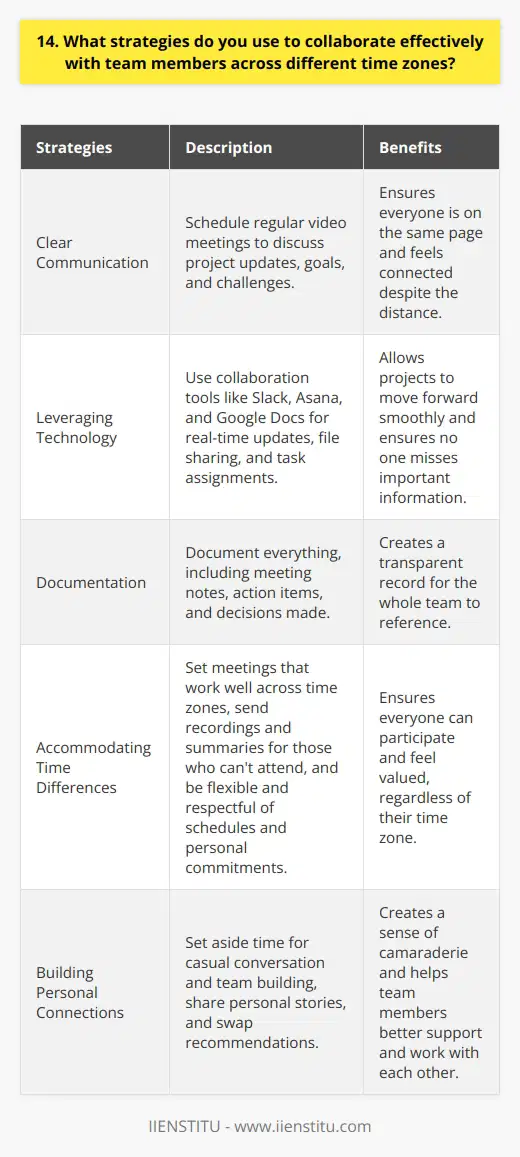
15. How do you maintain a professional work environment at home to support your time management efforts?
Maintaining a professional work environment at home is crucial for effective time management. I've found that establishing a dedicated workspace, separate from personal living areas, helps me stay focused and productive.
Set Boundaries
I communicate my work hours to family and friends, so they know when I'm unavailable. This helps minimize distractions and interruptions during my workday.
Create a Routine
Following a consistent daily routine keeps me on track. I start my day early, tackling important tasks first when my energy and concentration are at their peak.
Take Breaks
Regular breaks are essential for maintaining productivity. I step away from my desk every hour or so to stretch, refocus, and recharge.
Utilize Technology
Tools like project management software and time tracking apps help me stay organized and accountable. I rely on these to prioritize tasks and meet deadlines.
Minimize Distractions
To avoid getting sidetracked, I silence notifications on my phone and computer during work hours. I also let household members know when I need quiet time to concentrate.
By implementing these strategies, I've been able to create a professional and productive home work environment that supports my time management efforts. It takes discipline and planning, but the payoff in terms of increased focus and output is well worth it.

16. What methods do you use to track your progress and ensure you meet your daily, weekly, or monthly goals?
I use a combination of digital tools and old-fashioned pen and paper to track my progress and goals. Every morning, I review my to-do list and prioritize tasks based on urgency and importance. Throughout the day, I update my task management app with completed items and new action steps.
Weekly Check-Ins
On Mondays, I have a standing meeting with myself to review the previous week's accomplishments and challenges. I celebrate wins, no matter how small, and reflect on lessons learned from setbacks. This helps me stay motivated and focused on continuous improvement.
Accountability Partners
I've found that having an accountability partner is crucial for staying on track. Every Friday, a colleague and I hop on a quick call to share our goals for the upcoming week. Knowing that someone is counting on me to follow through keeps me engaged and driven.
Visual Reminders
I'm a visual learner, so I like to create colorful mind maps and vision boards. Seeing my goals and dreams laid out in a creative format inspires me to take action. I hang these visual reminders near my workspace as a constant source of motivation.
Celebrating Milestones
When I reach a significant milestone or complete a challenging project, I take time to celebrate. Whether it's treating myself to a fancy latte or sharing my success with friends, acknowledging my hard work boosts my confidence and energy for the next goal ahead.
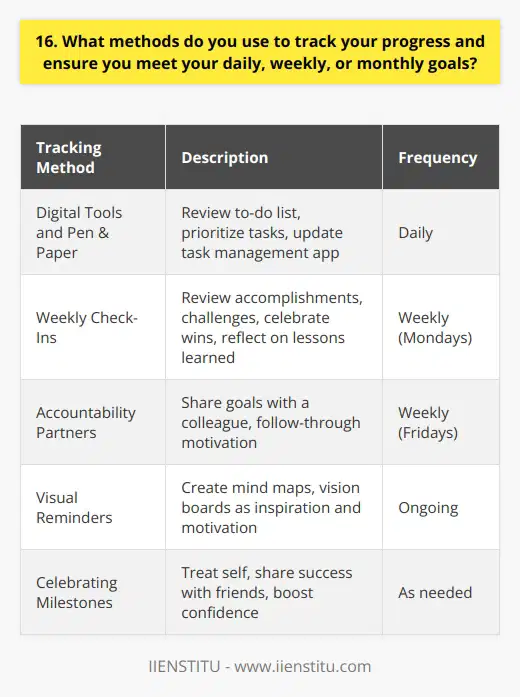
17. How do you handle the temptation to work longer hours when working remotely?
When working remotely, the temptation to work longer hours can be strong. After all, there's no commute and fewer distractions, right? Not so fast.
Set Boundaries and Stick to Them
I've found that setting clear work hours is crucial. When my workday ends, I step away from my computer and focus on personal time. This helps maintain a healthy work-life balance.
Communicate with Your Team
Let your colleagues know your schedule. If you receive after-hours messages, resist the urge to respond immediately unless it's truly urgent. Your team will understand and respect your boundaries.
Create a Dedicated Workspace
Having a designated home office space helps me mentally separate work from leisure. When I leave that space, I leave work behind too. It's a simple but effective psychological trick.
Prioritize Self-Care
Taking breaks, exercising, and spending time with loved ones are essential. I schedule these activities like I would any work task. My well-being comes first, and that makes me a better employee.
Focus on Results, Not Hours
I aim to be productive during my workday, not just busy. By prioritizing important tasks and minimizing distractions, I can accomplish more in less time. Quality trumps quantity.
Remember, overworking leads to burnout, not success. Trust me, I've been there! By setting boundaries, communicating, and prioritizing self-care, you can thrive while working remotely.

18. What strategies do you use to set boundaries between work and personal life when your home is your office?
Setting boundaries between work and personal life is crucial when working from home. I have developed several strategies to maintain a healthy work-life balance.
Dedicated Workspace
I create a designated workspace separate from my living area. This helps me mentally shift into work mode and minimizes distractions. When I step into my home office, my brain knows it's time to focus on work tasks.
Set Working Hours
I establish clear working hours and communicate them to my colleagues and family members. During these hours, I concentrate solely on work responsibilities. Once my workday ends, I make a conscious effort to disconnect and enjoy personal time.
Take Breaks
Taking regular breaks throughout the day is essential for my well-being. I step away from my desk, stretch, and engage in brief relaxation techniques. These breaks help me recharge and return to work with renewed focus.
Prioritize Self-Care
I prioritize self-care activities like exercise, meditation, and hobbies outside of work hours. Engaging in these activities helps me maintain a sense of balance and reduces stress levels. When I feel fulfilled personally, I perform better professionally.
Communicate Expectations
Open communication is key. I discuss my boundaries and expectations with my team and family. By clearly expressing when I am available and when I need uninterrupted work time, I create a supportive environment that respects my work-life balance.
Implementing these strategies has been a learning process, but they have significantly improved my productivity and overall well-being while working from home.
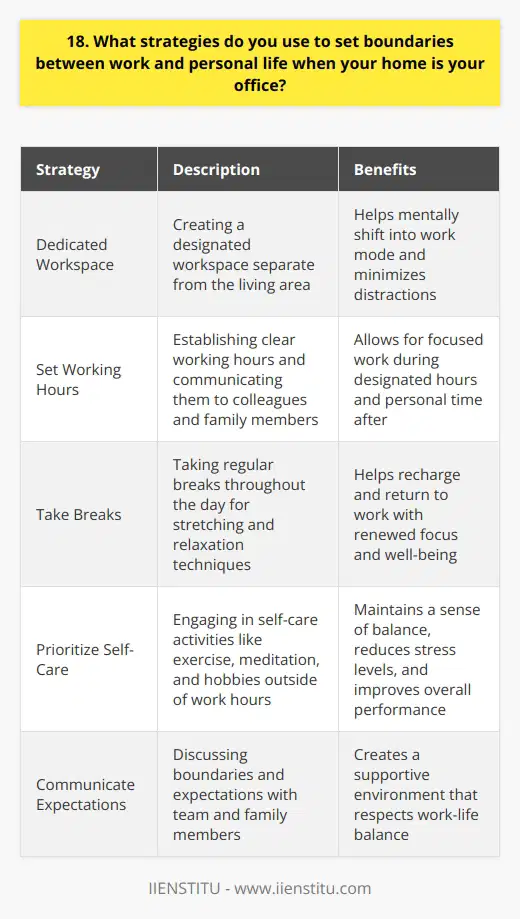
19. How do you manage your time when faced with technical difficulties or connectivity issues while working remotely?
When faced with technical difficulties or connectivity issues while working remotely, I take a proactive approach to manage my time effectively. Here are some strategies I employ:
Prioritize and Adapt
I quickly assess the impact of the technical issue on my tasks and prioritize accordingly. If a task requires the affected system or connection, I shift my focus to other important work that I can complete offline or using alternative methods. Being flexible allows me to make the most of my time.
Troubleshoot and Seek Support
While working on other tasks, I simultaneously troubleshoot the technical problem to the best of my abilities. I check connections, restart devices, and consult documentation or online resources for solutions. If the issue persists, I promptly reach out to the appropriate IT support channels, providing clear details to expedite a resolution.
Communicate and Collaborate
I maintain open communication with my team and stakeholders during technical challenges. I promptly inform them of any delays or limitations caused by the issue, and propose alternative ways to collaborate or share information. Keeping everyone updated helps manage expectations and ensures smooth teamwork.
Plan and Prepare
To minimize the impact of future technical difficulties, I proactively plan my work. I regularly save my progress, use cloud-based storage for important files, and keep offline copies of critical resources. Having contingency plans and backup methods helps me stay productive even when faced with unexpected disruptions.
By staying organized, communicative, and adaptable, I can effectively manage my time and maintain productivity during technical challenges while working remotely.
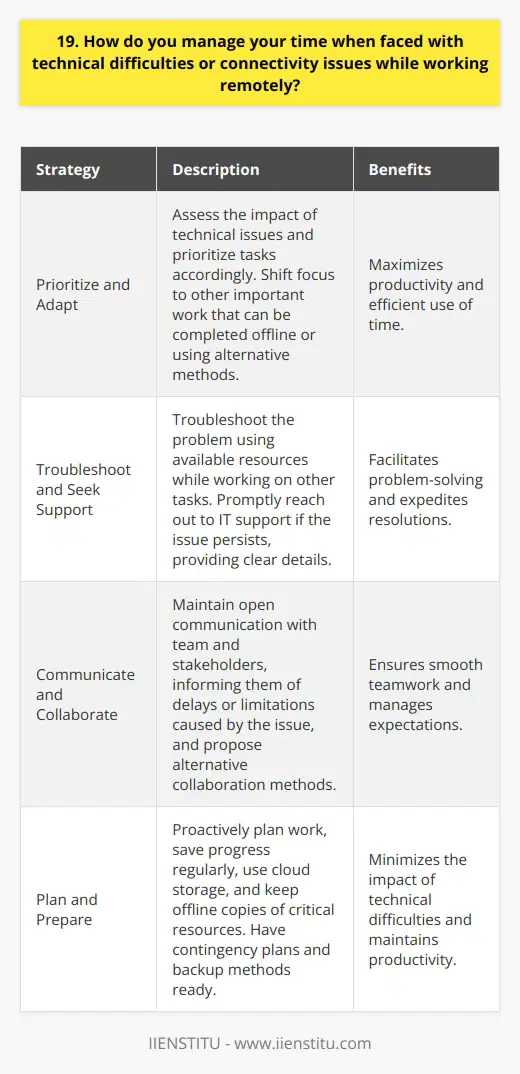
20. What techniques do you use to stay organized and manage your email and other communications effectively?
To stay organized and manage my email and other communications effectively, I rely on a combination of techniques. First, I prioritize my inbox by flagging important messages and setting reminders for time-sensitive tasks. This helps me focus on what matters most and ensures nothing falls through the cracks.
Categorizing Communications
I also categorize my emails into folders based on projects, clients, or topics. This makes it easy to find specific threads later on and keeps my inbox clutter-free. For other communications like instant messages or project management tools, I use a similar system of categorization to maintain order.
Scheduling Dedicated Time
Another key strategy is scheduling dedicated time blocks for responding to emails and messages. I find that batching these tasks helps me be more efficient and avoids constant distractions throughout the day. During these focused sessions, I can provide thoughtful responses and follow up on any action items.
Leveraging Technology
Finally, I leverage technology to streamline my communication workflows. I use tools like email templates for common responses, filters to automatically sort incoming messages, and calendar integrations to schedule meetings seamlessly. By automating repetitive tasks, I can spend more time on high-value work that drives results.
At the end of the day, staying organized with communications comes down to having a system and sticking to it. Through trial and error, I've developed an approach that works well for me and enables me to be responsive, efficient, and focused in my role.
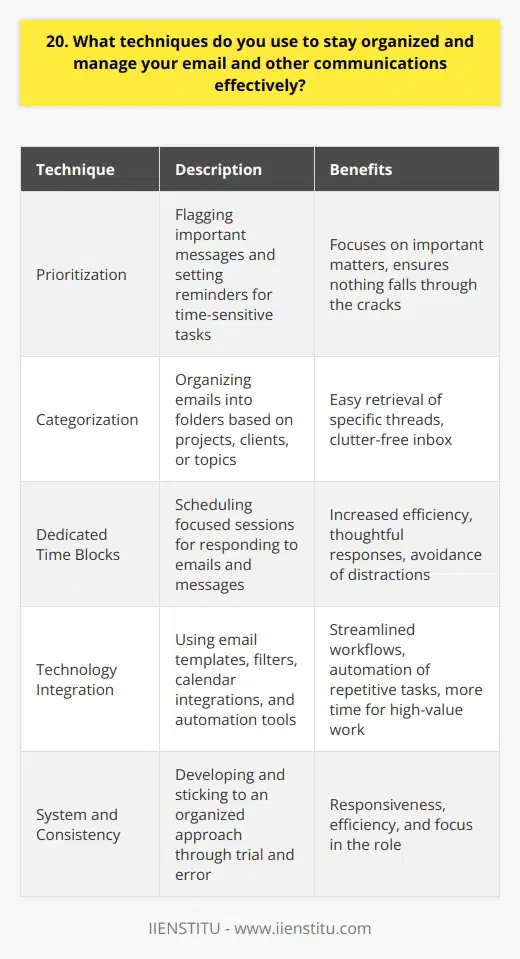
21. How do you prioritize tasks when you have competing deadlines or urgent requests from multiple stakeholders?
When faced with competing deadlines and urgent requests from multiple stakeholders, I rely on a few key strategies to prioritize my tasks effectively.
Assess the Impact and Urgency
First, I evaluate each task based on its potential impact and urgency. I ask myself, "Which tasks will have the greatest effect on our goals and need to be completed most quickly?" This helps me identify the top priorities.
Communicate with Stakeholders
Next, I reach out to the relevant stakeholders to clarify expectations and deadlines. Open communication is essential for understanding the full context behind each request. I've found that a quick phone call can often provide much-needed perspective.
Break Down Tasks
For complex projects, I break them down into smaller, manageable steps. This makes even the most daunting tasks feel achievable. I focus on completing one piece at a time to keep making steady progress.
Stay Flexible
Finally, I remain adaptable. Priorities can change quickly, so I'm always ready to re-assess and re-allocate my time as needed. Being flexible allows me to handle any last-minute requests that come my way.
By using these strategies, I'm able to stay organized, keep stakeholders happy, and deliver quality work on time, even under pressure. It's an approach I've refined over many years in fast-paced work environments.
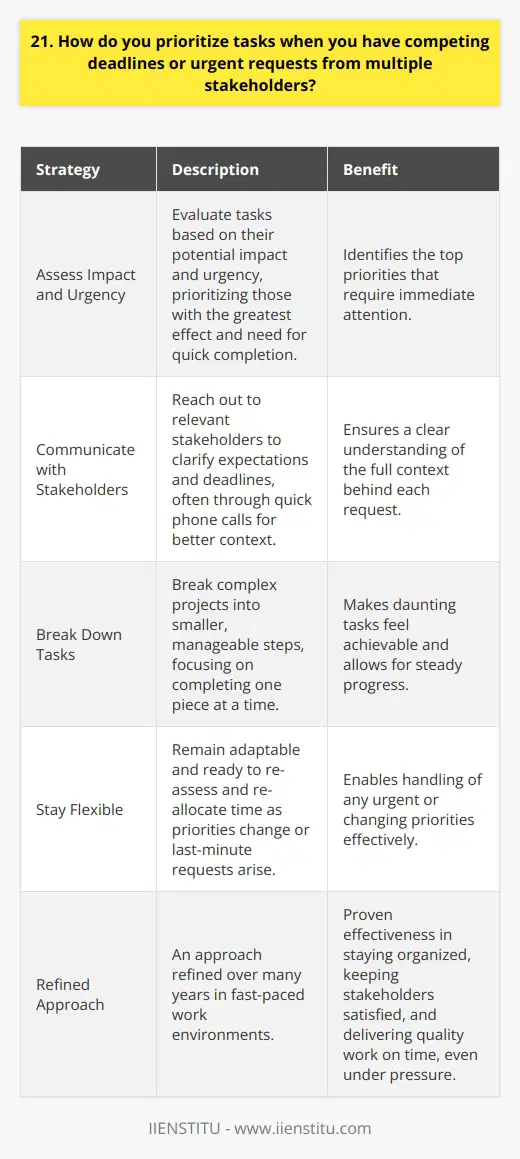
22. What methods do you use to estimate the time required for tasks and projects when working remotely?
When estimating the time required for tasks and projects while working remotely, I rely on a few key methods. First, I break down the project into smaller, manageable tasks. This helps me accurately assess the time each component will take.
Setting realistic deadlines
I also consider any potential roadblocks or challenges that may arise during the project. By factoring in these considerations, I can set realistic deadlines for myself and my team. Communication is crucial when working remotely, so I make sure to regularly check in with my colleagues.
Utilizing project management tools
Utilizing project management tools like Trello or Asana helps me stay organized and on track. These platforms allow me to assign tasks, set due dates, and monitor progress. I find that having a visual representation of the project timeline keeps me accountable and motivated.
Drawing from past experiences
When estimating time for a project, I often draw from my past experiences with similar tasks. If I've worked on a comparable assignment before, I have a better understanding of how long it might take. Of course, every project is unique, so I adjust my estimates accordingly.
Allowing for flexibility
Lastly, I always try to build in some flexibility into my timelines. Unexpected issues can pop up, especially when working remotely. By giving myself a bit of wiggle room, I can adapt to any changes or challenges that come my way.
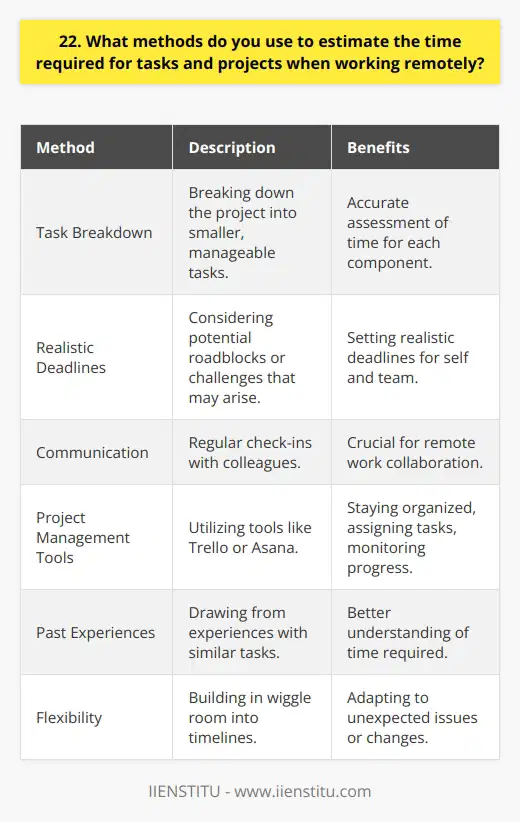
23. How do you ensure you have a clear understanding of your goals and objectives when working independently?
When working independently, I ensure a clear understanding of my goals and objectives through several key strategies:
Clarifying expectations upfront
I always make sure to ask questions and clarify the desired outcomes before starting a project. This helps me fully grasp what needs to be accomplished.
Breaking down larger goals into smaller tasks
Once I understand the big picture, I break it down into manageable steps. This allows me to create a roadmap and stay on track.
Setting milestones and deadlines
I establish checkpoints along the way to ensure I'm making steady progress. Having target dates keeps me motivated and accountable.
Regularly communicating with stakeholders
Even when working independently, I believe in keeping open lines of communication. I provide updates and seek feedback to confirm I'm aligned with expectations.
Assessing and adjusting as needed
Throughout the process, I periodically evaluate my work against the objectives. If I encounter challenges or see room for improvement, I adapt my approach accordingly.
By following these practices, I'm able to stay focused, productive, and on target when working on my own. I take ownership of my projects and pride in delivering quality results.

24. What strategies do you use to maintain regular communication with your supervisor or manager when working remotely?
When working remotely, I believe that maintaining regular communication with my supervisor is crucial for success. I utilize various strategies to ensure consistent and effective communication, even when we're not in the same physical location.
Scheduled Check-Ins
I always make sure to schedule regular check-ins with my manager, either through video calls or phone conversations. During these meetings, I provide updates on my progress, discuss any challenges I'm facing, and seek guidance when needed. I find that having these scheduled touchpoints helps keep everyone on the same page and ensures that I'm aligned with my supervisor's expectations.
Proactive Updates
In addition to scheduled check-ins, I also take a proactive approach to communication. Whenever I make significant progress on a project or encounter any roadblocks, I reach out to my supervisor via email or instant messaging to keep them informed. I believe that proactively sharing information helps build trust and demonstrates my commitment to keeping my manager in the loop.
Utilizing Collaboration Tools
I leverage various collaboration tools to facilitate seamless communication with my supervisor and team members. Whether it's using project management software to track tasks and deadlines or utilizing instant messaging platforms for quick discussions, I make sure to stay connected and accessible. These tools help bridge the gap and ensure that everyone is on the same page, regardless of our physical locations.
Clarity and Transparency
When communicating with my supervisor, I prioritize clarity and transparency. I strive to be concise in my messages, providing all the necessary details while avoiding unnecessary jargon or ambiguity. If there are any uncertainties or if I need further guidance, I don't hesitate to ask questions. I believe that open and honest communication is the foundation of a strong working relationship, especially in a remote setting.
By implementing these strategies, I have been able to maintain effective communication with my supervisors while working remotely. I understand the importance of staying connected, being proactive, and ensuring clarity in all interactions. With the right approach and tools, I am confident in my ability to collaborate successfully with my manager, even when we're not in the same physical location.

25. How do you handle the need for impromptu discussions or brainstorming sessions with colleagues in a remote setting?
I handle impromptu discussions and brainstorming sessions with colleagues in a remote setting by being proactive and adaptable. When inspiration strikes or an issue arises, I reach out to my team via our preferred communication channels.
Leveraging Technology
I'm comfortable using various collaboration tools like Slack, Zoom, or Microsoft Teams to facilitate quick, efficient conversations. These platforms allow for seamless video calls, screen sharing, and instant messaging, making it easy to bounce ideas off each other and come up with creative solutions.
Scheduling Timely Meetings
If a discussion requires more than a few minutes, I propose a timely meeting to gather everyone's input. I'm mindful of my colleagues' schedules and work across time zones to find a slot that suits all.
Encouraging Open Communication
I foster an environment where everyone feels heard and valued. I actively listen to my teammates' perspectives and encourage them to share their thoughts openly. By creating a safe space for brainstorming, we can generate innovative ideas and solve problems collaboratively.
Following Up and Implementing Ideas
After our discussions, I take the initiative to summarize key points and action items. I follow up with my colleagues to ensure we're all on the same page and moving forward with our plans. By taking ownership of the process, I help turn our impromptu sessions into tangible results.
In summary, I embrace the challenges and opportunities of remote collaboration by being adaptable, proactive, and inclusive. With the right tools and mindset, impromptu discussions and brainstorming sessions can be just as effective and rewarding as in-person interactions.

26. What techniques do you use to manage stress and maintain a positive mindset when faced with time management challenges?
When faced with time management challenges, I employ several techniques to manage stress and maintain a positive mindset:
Prioritizing Tasks
I start by creating a to-do list and prioritizing tasks based on urgency and importance. This helps me focus on what matters most and reduces feelings of being overwhelmed.
Breaking Down Projects
For larger projects, I break them down into smaller, manageable chunks. Tackling one piece at a time makes the overall task feel less daunting and allows me to celebrate small victories along the way.
Setting Realistic Goals
I set realistic goals for myself, considering my capabilities and available resources. Trying to do too much too quickly is a recipe for stress, so I aim for achievable targets.
Practicing Mindfulness
When stress levels rise, I take a few minutes to practice mindfulness techniques like deep breathing or meditation. These brief mental breaks help me refocus and approach challenges with a calmer, clearer perspective.
Maintaining Work-Life Balance
I strive to maintain a healthy work-life balance by setting boundaries and making time for self-care activities. Regular exercise, hobbies, and quality time with loved ones help me recharge and manage stress more effectively.
By employing these techniques consistently, I've found that I'm better equipped to handle time management challenges while maintaining a positive outlook. It's an ongoing process, but one that has served me well both professionally and personally.
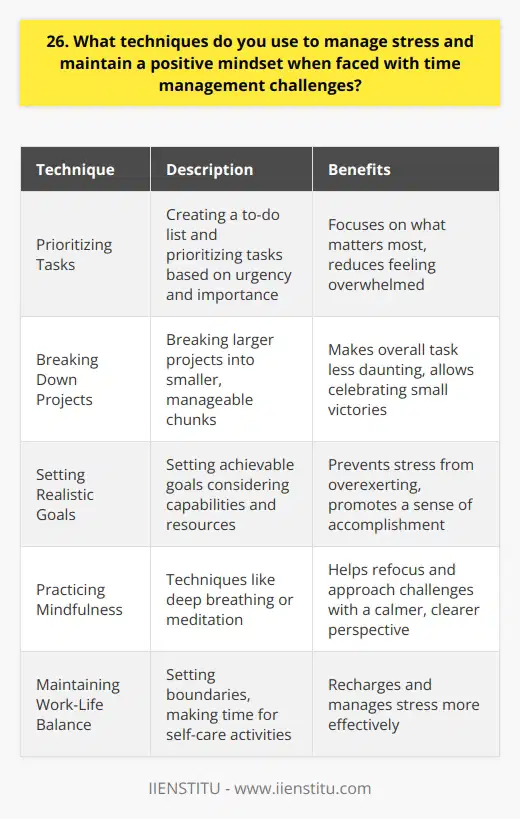
27. How do you ensure you have access to the necessary resources and information to complete your tasks efficiently?
When starting a new project or task, I always begin by identifying the resources and information needed for success. This includes any relevant data, documents, software, or tools required to complete the work efficiently.
Collaborate with Team Members
I proactively reach out to colleagues and stakeholders who may have valuable insights or resources to share. By fostering open communication and collaboration, I can tap into the collective knowledge of my team.
Example:
In my previous role, I worked on a complex marketing campaign. I scheduled brainstorming sessions with the creative team to gather fresh ideas and perspectives, which ultimately led to a highly successful campaign.
Utilize Company Resources
I familiarize myself with the company's internal resources, such as shared drives, knowledge bases, and training materials. These resources often contain a wealth of information that can help me work more effectively.
Example:
When I joined my current company, I spent time exploring our internal wiki and attending training sessions. This allowed me to quickly get up to speed on company processes and best practices.
Stay Organized and Plan Ahead
I maintain a well-organized system for storing and accessing information, so I can quickly find what I need. I also plan ahead and anticipate the resources I'll need for upcoming projects.
Example:
Before starting a new project, I create a detailed plan outlining the steps involved and the resources required for each phase. This helps me stay organized and ensures I have everything I need to complete the work efficiently.

28. What methods do you use to prioritize your professional development and learning opportunities while working remotely?
As a remote worker, I've developed several strategies to prioritize my professional development and learning opportunities. I believe that continuous learning is essential for personal and professional growth, especially in a remote work environment.
Setting Clear Goals
I start by setting clear, achievable goals for my professional development. I identify the skills and knowledge I need to acquire to excel in my role and advance my career. By having a clear roadmap, I can prioritize learning opportunities that align with my goals.
Allocating Dedicated Time
I allocate dedicated time for learning and professional development. I block off time on my calendar each week to engage in learning activities, such as attending webinars, reading industry publications, or taking online courses. Treating learning as a priority helps me stay committed to my growth.
Leveraging Online Resources
I take advantage of the vast array of online resources available for remote learning. I explore platforms like Coursera, edX, and LinkedIn Learning to find relevant courses and certifications. I also participate in virtual conferences and workshops to stay up-to-date with industry trends and best practices.
Collaborating with Colleagues
I actively seek opportunities to collaborate with my colleagues on projects that stretch my skills and knowledge. By working on diverse projects and learning from my peers, I can expand my expertise and gain new perspectives. I also engage in knowledge-sharing sessions with my team to learn from their experiences and insights.
Seeking Feedback and Mentorship
I proactively seek feedback from my manager and colleagues to identify areas for improvement and growth. I also seek out mentors within my organization or industry who can provide guidance and support in my professional development journey. Their advice and insights help me make informed decisions about learning opportunities.
By combining these strategies, I ensure that I'm continuously learning and growing as a remote professional. I'm committed to staying curious, adaptable, and proactive in my approach to professional development.

29. How do you maintain a sense of connection and teamwork with your colleagues when working independently?
I maintain a strong sense of connection and teamwork with my colleagues, even when working independently, through regular communication and collaboration. I make it a point to stay in touch with my team members through various channels, such as email, instant messaging, or video calls, to keep everyone informed about my progress and to seek their input when needed.
Sharing Knowledge and Ideas
I actively participate in team meetings and brainstorming sessions to share my ideas and insights with my colleagues. I believe that everyone brings a unique perspective to the table, and by sharing our knowledge and experiences, we can come up with innovative solutions to challenges.
Offering Support and Assistance
Whenever a colleague needs help or guidance, I am always ready to lend a hand. I believe that supporting each other is crucial for maintaining a strong sense of teamwork, even when working independently. By being there for my teammates, I foster a culture of collaboration and mutual respect.
Celebrating Successes Together
I make sure to celebrate the successes of my colleagues, no matter how small they may seem. Whether it's a project milestone or a personal achievement, I take the time to acknowledge and congratulate my team members. This helps to build a positive team spirit and reinforces the idea that we are all working towards a common goal.
In my previous role, I worked remotely for several months due to the pandemic. Despite the physical distance, I made sure to stay connected with my colleagues through regular check-ins and virtual team-building activities. By maintaining open lines of communication and showing genuine interest in their well-being, I was able to maintain a strong sense of connection and teamwork, even when working independently.

30. What strategies do you use to adapt your time management techniques to the unique demands of remote work?
When it comes to adapting my time management techniques for remote work, I have a few key strategies. First and foremost, I create a dedicated workspace that allows me to focus without distractions. This helps me get into the right mindset for productive work, even if I'm not in a traditional office setting.
Prioritizing Tasks and Setting Boundaries
I prioritize my tasks based on urgency and importance, ensuring that I tackle the most critical items first. I also set clear boundaries between work and personal time, which is especially important when working from home. I communicate my availability to my team and make sure to disconnect when my workday is done.
Leveraging Technology and Communication Tools
To stay connected with my colleagues, I leverage various communication tools like video conferencing and instant messaging. These tools help me collaborate effectively, even when we're not in the same physical location. I also use project management software to keep track of deadlines, assign tasks, and monitor progress.
Maintaining a Routine and Taking Breaks
Another important strategy is maintaining a consistent routine, just as I would in an office setting. I start my day at the same time, take regular breaks to recharge, and have a set end time for my workday. This helps me maintain a healthy work-life balance and avoid burnout.
Adapting and Staying Flexible
Finally, I recognize that remote work requires a certain level of adaptability and flexibility. If something isn't working, I'm not afraid to adjust my approach and try new strategies. I stay open to feedback from my team and continuously look for ways to improve my time management skills in a remote work environment.
